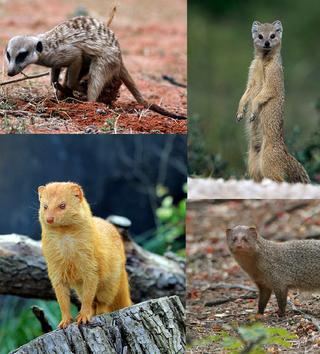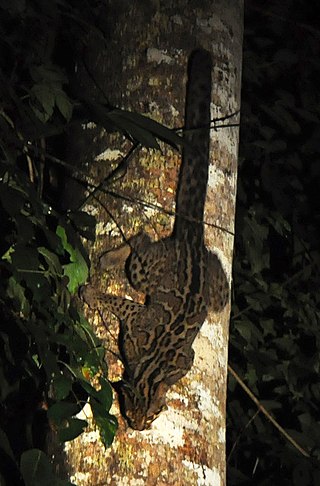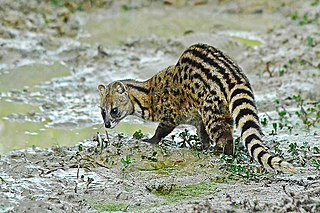
The leopard is one of the five extant species in the genus Panthera. It has a pale yellowish to dark golden fur with dark spots grouped in rosettes. Its body is slender and muscular reaching a length of 92–183 cm (36–72 in) with a 66–102 cm (26–40 in) long tail and a shoulder height of 60–70 cm (24–28 in). Males typically weigh 30.9–72 kg (68–159 lb), and females 20.5–43 kg (45–95 lb).

A mongoose is a small terrestrial carnivorous mammal belonging to the family Herpestidae. This family is currently split into two subfamilies, the Herpestinae and the Mungotinae. The Herpestinae comprises 23 living species that are native to southern Europe, Africa and Asia, whereas the Mungotinae comprises 11 species native to Africa. The Herpestidae originated about 21.8 ± 3.6 million years ago in the Early Miocene and genetically diverged into two main genetic lineages between 19.1 and 18.5 ± 3.5 million years ago.

The fishing cat is a medium-sized wild cat of South and Southeast Asia. Since 2016, it is listed as Vulnerable on the IUCN Red List. Fishing cat populations are threatened by destruction of wetlands and have declined severely over the last decade. The fishing cat lives foremost in the vicinity of wetlands, along rivers, streams, oxbow lakes, in swamps, and mangroves.

The nilgai is the largest antelope of Asia, and is ubiquitous across the northern Indian subcontinent. It is the sole member of the genus Boselaphus, which was first described by Peter Simon Pallas in 1766. The nilgai stands 1–1.5 m (3.3–4.9 ft) at the shoulder; males weigh 109–288 kg (240–635 lb), and the lighter females 100–213 kg (220–470 lb). A sturdy thin-legged antelope, the nilgai is characterised by a sloping back, a deep neck with a white patch on the throat, a short crest of hair along the neck terminating in a tuft, and white facial spots. A column of pendant coarse hair hangs from the dewlap ridge below the white patch. Sexual dimorphism is prominent – while females and juveniles are orange to tawny, adult males have a bluish-grey coat. Only males possess horns, 15–24 cm (5.9–9.4 in) long.

The marbled cat is a small wild cat native from the eastern Himalayas to Southeast Asia, where it inhabits forests up to an elevation of 2,500 m (8,200 ft). As it is present in a large range, it has been listed as Near Threatened on the IUCN Red List since 2015.

Gongylus gongylodes, also known as the wandering violin mantis, ornate mantis, or Indian rose mantis, is a species of praying mantis in the family Empusidae. Characterized by extremely slender limbs with large appendages, it is not a particularly aggressive species and often kept as a pet. The mantis is especially known for swaying its body back and forth to imitate a stick flowing in the wind. It primarily feeds on flying insects. Its native range is in southern India and Sri Lanka. It can reach up to 11 cm (4.3 in) long. The males of the species are capable of flight. They are a communal species, in that they are able to live and breed in large groups, without unnecessary cannibalism. Adult females are about 10cm and adult males are about 9 cm.
Benoy Krishna Tikader (1928–1994) was an Indian arachnologist and zoologist and a leading expert on Indian spiders in his time. He worked in the Zoological Survey of India and published the Handbook of Indian Spiders in 1987. The book describes 40 families and 1066 species of India, many of which were described by Tikader himself. The handbook is a guide to all arachnids including scorpions, and not just spiders. He was also a popular scientific author in his native language of Bengali, and was the author of Banglar Makorsha for the layman.

The Namdapha flying squirrel is a flying squirrel endemic to Arunachal Pradesh in northeast India, where it is known from a single zoological specimen collected in Namdapha National Park in 1981.
Theodore Edward Cantor (1809–1860) was a Danish physician, zoologist and botanist. He described several new species of reptiles and amphibians, and six species have been named in his honor.

Kolkata is the prime business, commercial and financial hub of eastern India and the main hub of communication for the North East Indian states. Kolkata is the third largest city by GDP in India after Mumbai and Delhi, with a GDP of $160 billion (PPP). Kolkata is home to India's oldest, stock exchange company (bourse) – The Calcutta Stock Exchange. Kolkata is home to many industrial units operated by large public- and private-sector corporations; major sectors include Steel, Heavy engineering, Mining, Minerals, cement, pharmaceuticals, Food processing, Agriculture, electronics, textiles, and jute.

The small Indian civet is a civet native to South and Southeast Asia. It is listed as Least Concern on the IUCN Red List because of its widespread distribution, widespread habitat use and healthy populations living in agricultural and secondary landscapes of many range states.

Kailash Sankhala was an Indian biologist and conservationist. He was the Director of Delhi Zoological Park and Chief Wildlife Warden of Rajasthan. He is best known for his work in preserving tigers. Sankhala was the first Director of Project Tiger, a conservation programme set up in India in 1973. He was well known as "The Tiger Man of India". He was awarded the Padma Shri in 1992 and Rajasthan Ratan in 2013.

The Zoological Survey of India (ZSI), founded on 1 July 1916 by the Ministry of Environment, Forest and Climate Change of the Government of India as a premier Indian organisation in zoological research and studies to promote the survey, exploration and research of the fauna in the country.
Mohammad Shamim Jairajpuri was an Indian zoologist. He served as a professor and Chairman of the Zoology Department and Dean of the Faculty of Life Sciences at Aligarh Muslim University Aligarh before retirement in 2004. He received the first Janaki Ammal National Award bestowed by the Government of India, Ministry of Environment & Forests and Lifetime Achievement Award from the Zoological Society of India for his notable works on taxonomy of nematodes (1964–2004).
Madhu Sudan Kanungo was an Indian scientist in the field of gerontology and neuroscience as well as a teacher of molecular biology and biochemistry. He is known for his theories on how gene expression changes with age and the role of this phenomenon in ageing, which is a widely accepted as "Gene expression theory of Aging". In recognition of his contributions, he was awarded India's fourth highest civilian award, Padma Shri in 2005. He held the post of BHU Emeritus professor in zoology at the Banaras Hindu University and was also the Chancellor, Nagaland University till his death.
Narayana Balakrishnan Nair (1927–2010) was a marine biologist, ecologist and the founder president of Kerala Science Congress. He was known for his advocacy of trawling ban during monsoon seasons which was later accepted and imposed by the Government of Kerala. A Jawaharlal Nehru fellow, Nair was an elected fellow of all the major Indian science academies as well as the Zoological Society of London. The Council of Scientific and Industrial Research, the apex agency of the Government of India for scientific research, awarded him the Shanti Swarup Bhatnagar Prize for Science and Technology, one of the highest Indian science awards, in 1971, for his contributions to biological sciences. He received the fourth highest Indian civilian honor of the Padma Shri in 1984.
Emoia baudini, also known commonly as Baudin's emo skink, Baudin's skink, and the Great Bight cool-skink, is a species of lizard in the family Scincidae. The species is native to New Guinea, Maluku, and Sulawesi.

Phoboscincus garnieri, also known commonly as Garnier's giant skink and Garnier's skink, is a species of lizard in the family Scincidae. The species is endemic to New Caledonia.
Gongylus pauperatus is an praying mantis in the family Empusidae. Its generic name Gongylus means "roundish" in Greek.












